sensor BMW 535D 2014 Owner's Manual
[x] Cancel search | Manufacturer: BMW, Model Year: 2014, Model line: 535D, Model: BMW 535D 2014Pages: 267, PDF Size: 5.88 MB
Page 149 of 267
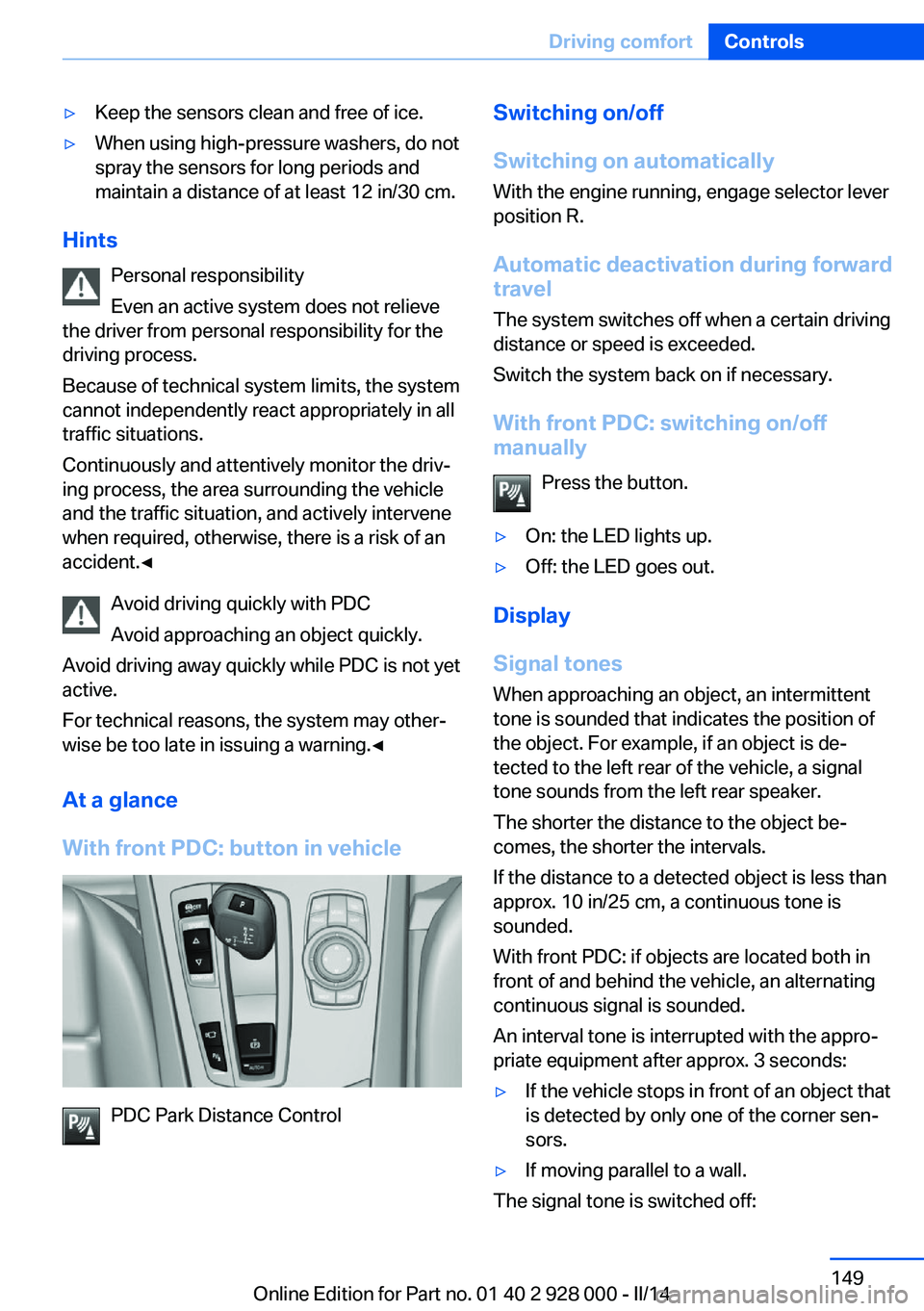
‚Ė∑Keep the sensors clean and free of ice.‚Ė∑When using high-pressure washers, do not
spray the sensors for long periods and
maintain a distance of at least 12 in/30 cm.
Hints
Personal responsibility
Even an active system does not relieve
the driver from personal responsibility for the
driving process.
Because of technical system limits, the system
cannot independently react appropriately in all
traffic situations.
Continuously and attentively monitor the driv‚Äź
ing process, the area surrounding the vehicle
and the traffic situation, and actively intervene
when required, otherwise, there is a risk of an
accident.‚óÄ
Avoid driving quickly with PDC
Avoid approaching an object quickly.
Avoid driving away quickly while PDC is not yet
active.
For technical reasons, the system may other‚Äź
wise be too late in issuing a warning.‚óÄ
At a glance
With front PDC: button in vehicle
PDC Park Distance Control
Switching on/off
Switching on automatically With the engine running, engage selector lever
position R.
Automatic deactivation during forward
travel
The system switches off when a certain driving
distance or speed is exceeded.
Switch the system back on if necessary.
With front PDC: switching on/off
manually
Press the button.‚Ė∑On: the LED lights up.‚Ė∑Off: the LED goes out.
Display
Signal tones When approaching an object, an intermittent
tone is sounded that indicates the position of
the object. For example, if an object is de‚Äź
tected to the left rear of the vehicle, a signal
tone sounds from the left rear speaker.
The shorter the distance to the object be‚Äź
comes, the shorter the intervals.
If the distance to a detected object is less than
approx. 10 in/25 cm, a continuous tone is
sounded.
With front PDC: if objects are located both in
front of and behind the vehicle, an alternating
continuous signal is sounded.
An interval tone is interrupted with the appro‚Äź
priate equipment after approx. 3 seconds:
‚Ė∑If the vehicle stops in front of an object that
is detected by only one of the corner sen‚Äź
sors.‚Ė∑If moving parallel to a wall.
The signal tone is switched off:
Seite 149Driving comfortControls149
Online Edition for Part no. 01 40 2 928 000 - II/14
Page 150 of 267
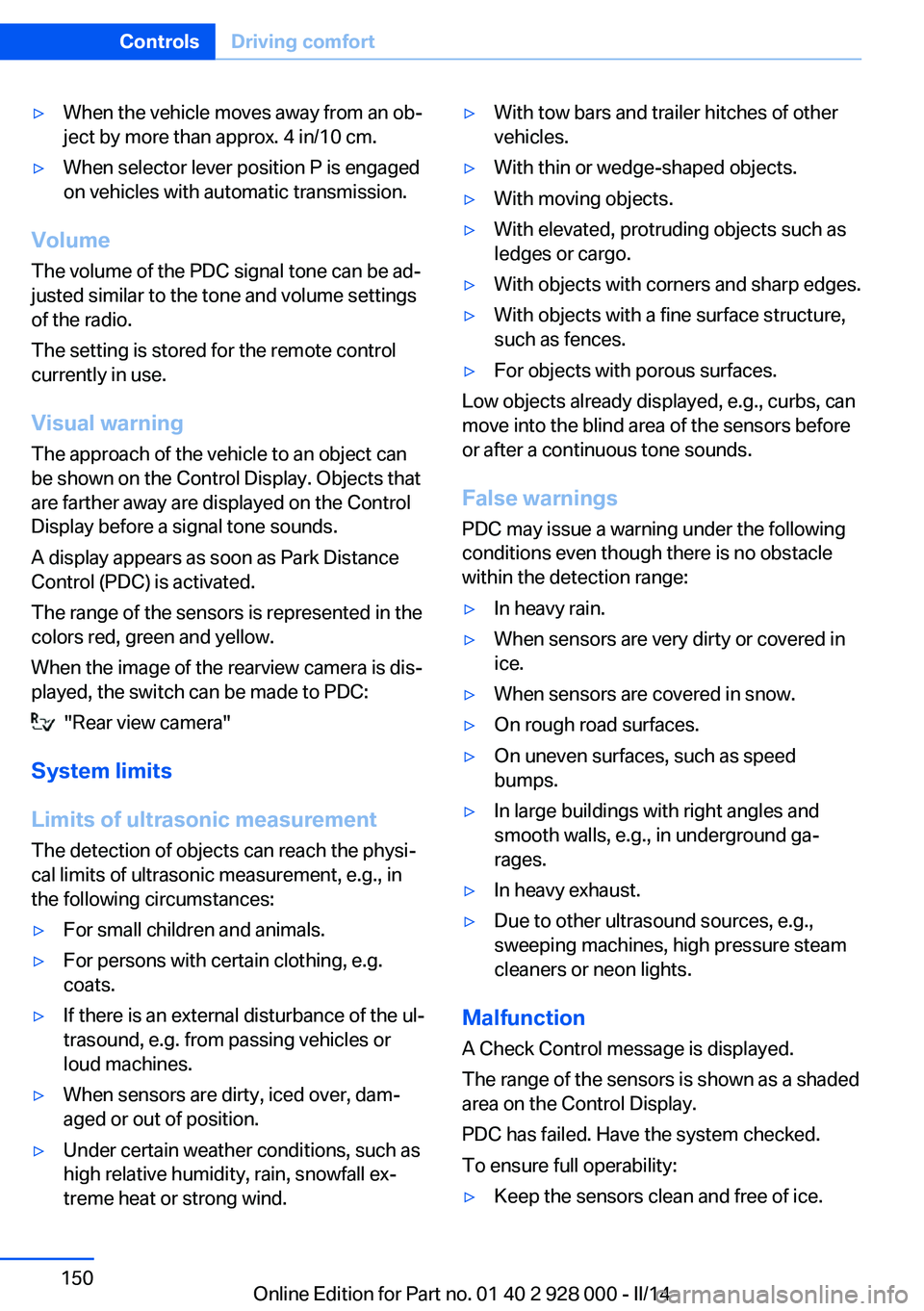
‚Ė∑When the vehicle moves away from an ob‚Äź
ject by more than approx. 4 in/10 cm.‚Ė∑When selector lever position P is engaged
on vehicles with automatic transmission.
Volume
The volume of the PDC signal tone can be ad‚Äź
justed similar to the tone and volume settings
of the radio.
The setting is stored for the remote control
currently in use.
Visual warning
The approach of the vehicle to an object can
be shown on the Control Display. Objects that
are farther away are displayed on the Control
Display before a signal tone sounds.
A display appears as soon as Park Distance
Control (PDC) is activated.
The range of the sensors is represented in the
colors red, green and yellow.
When the image of the rearview camera is dis‚Äź
played, the switch can be made to PDC:
"Rear view camera"
System limits
Limits of ultrasonic measurement The detection of objects can reach the physi‚Äź
cal limits of ultrasonic measurement, e.g., in
the following circumstances:
‚Ė∑For small children and animals.‚Ė∑For persons with certain clothing, e.g.
coats.‚Ė∑If there is an external disturbance of the ul‚Äź
trasound, e.g. from passing vehicles or
loud machines.‚Ė∑When sensors are dirty, iced over, dam‚Äź
aged or out of position.‚Ė∑Under certain weather conditions, such as
high relative humidity, rain, snowfall ex‚Äź
treme heat or strong wind.‚Ė∑With tow bars and trailer hitches of other
vehicles.‚Ė∑With thin or wedge-shaped objects.‚Ė∑With moving objects.‚Ė∑With elevated, protruding objects such as
ledges or cargo.‚Ė∑With objects with corners and sharp edges.‚Ė∑With objects with a fine surface structure,
such as fences.‚Ė∑For objects with porous surfaces.
Low objects already displayed, e.g., curbs, can
move into the blind area of the sensors before
or after a continuous tone sounds.
False warnings
PDC may issue a warning under the following conditions even though there is no obstacle
within the detection range:
‚Ė∑In heavy rain.‚Ė∑When sensors are very dirty or covered in
ice.‚Ė∑When sensors are covered in snow.‚Ė∑On rough road surfaces.‚Ė∑On uneven surfaces, such as speed
bumps.‚Ė∑In large buildings with right angles and
smooth walls, e.g., in underground ga‚Äź
rages.‚Ė∑In heavy exhaust.‚Ė∑Due to other ultrasound sources, e.g.,
sweeping machines, high pressure steam
cleaners or neon lights.
Malfunction
A Check Control message is displayed.
The range of the sensors is shown as a shaded
area on the Control Display.
PDC has failed. Have the system checked.
To ensure full operability:
‚Ė∑Keep the sensors clean and free of ice.Seite 150ControlsDriving comfort150
Online Edition for Part no. 01 40 2 928 000 - II/14
Page 151 of 267
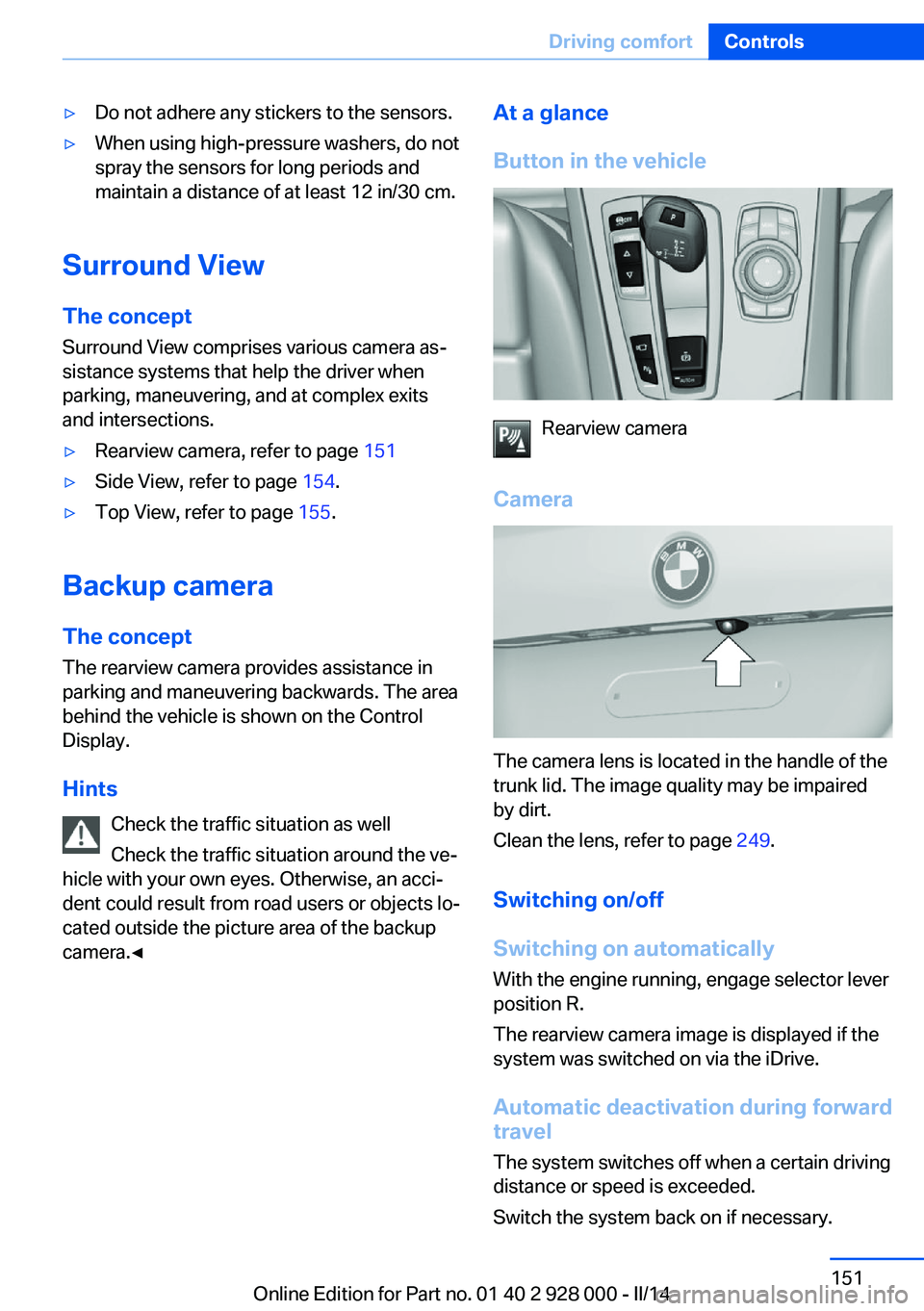
‚Ė∑Do not adhere any stickers to the sensors.‚Ė∑When using high-pressure washers, do not
spray the sensors for long periods and
maintain a distance of at least 12 in/30 cm.
Surround View
The concept Surround View comprises various camera as‚Äź
sistance systems that help the driver when
parking, maneuvering, and at complex exits
and intersections.
‚Ė∑Rearview camera, refer to page 151‚Ė∑Side View, refer to page 154.‚Ė∑Top View, refer to page 155.
Backup camera
The concept
The rearview camera provides assistance in
parking and maneuvering backwards. The area
behind the vehicle is shown on the Control
Display.
Hints Check the traffic situation as well
Check the traffic situation around the ve‚Äź
hicle with your own eyes. Otherwise, an acci‚Äź
dent could result from road users or objects lo‚Äź
cated outside the picture area of the backup
camera.‚óÄ
At a glance
Button in the vehicle
Rearview camera
Camera
The camera lens is located in the handle of the
trunk lid. The image quality may be impaired
by dirt.
Clean the lens, refer to page 249.
Switching on/off
Switching on automatically With the engine running, engage selector lever
position R.
The rearview camera image is displayed if the
system was switched on via the iDrive.
Automatic deactivation during forward
travel
The system switches off when a certain driving
distance or speed is exceeded.
Switch the system back on if necessary.
Seite 151Driving comfortControls151
Online Edition for Part no. 01 40 2 928 000 - II/14
Page 157 of 267
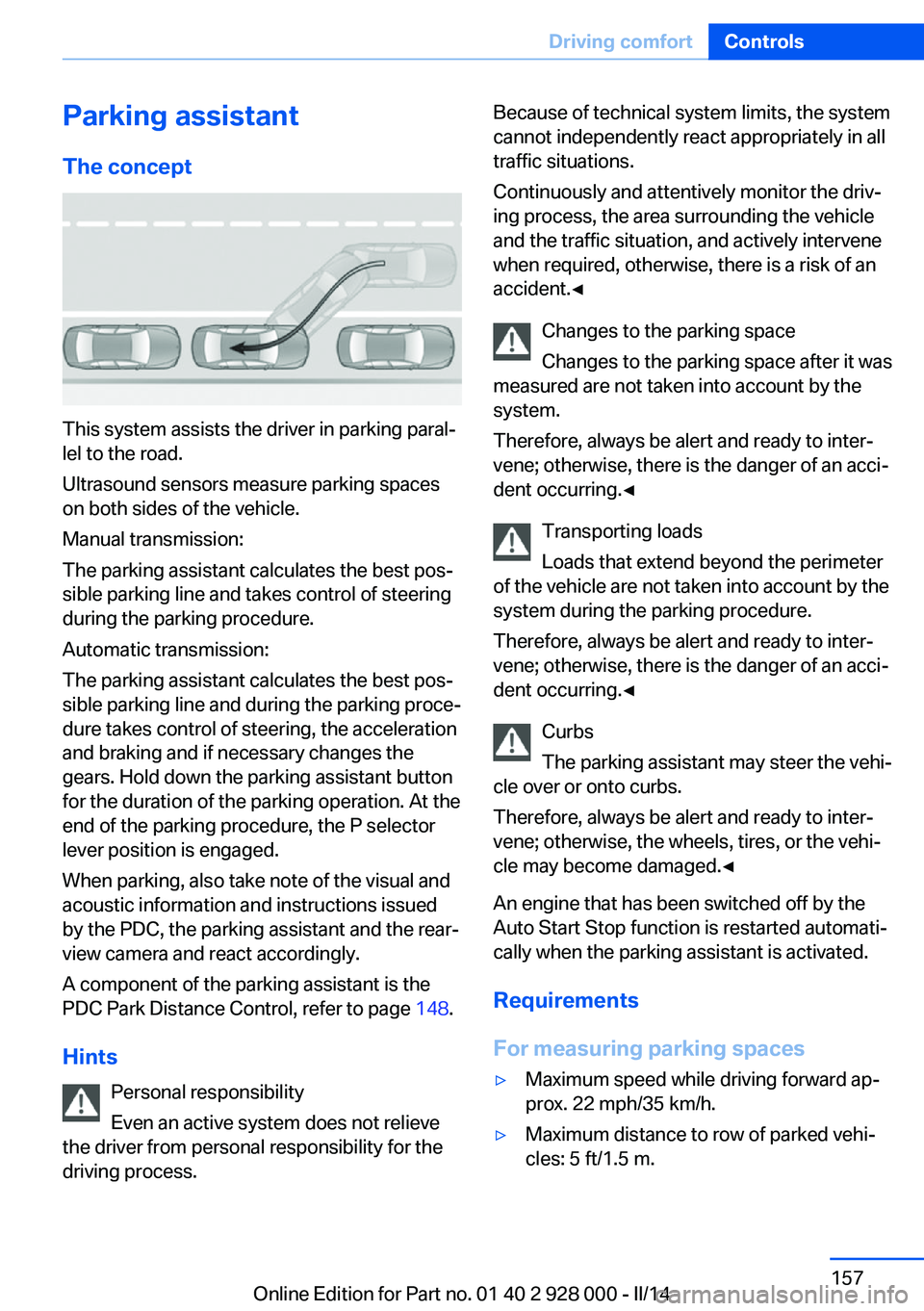
Parking assistantThe concept
This system assists the driver in parking paral‚Äź
lel to the road.
Ultrasound sensors measure parking spaces
on both sides of the vehicle.
Manual transmission:
The parking assistant calculates the best pos‚Äź
sible parking line and takes control of steering
during the parking procedure.
Automatic transmission:
The parking assistant calculates the best pos‚Äź
sible parking line and during the parking proce‚Äź
dure takes control of steering, the acceleration
and braking and if necessary changes the
gears. Hold down the parking assistant button
for the duration of the parking operation. At the
end of the parking procedure, the P selector
lever position is engaged.
When parking, also take note of the visual and
acoustic information and instructions issued
by the PDC, the parking assistant and the rear‚Äź
view camera and react accordingly.
A component of the parking assistant is the
PDC Park Distance Control, refer to page 148.
Hints Personal responsibility
Even an active system does not relieve
the driver from personal responsibility for the
driving process.
Because of technical system limits, the system
cannot independently react appropriately in all
traffic situations.
Continuously and attentively monitor the driv‚Äź
ing process, the area surrounding the vehicle
and the traffic situation, and actively intervene
when required, otherwise, there is a risk of an
accident.‚óÄ
Changes to the parking space
Changes to the parking space after it was
measured are not taken into account by the
system.
Therefore, always be alert and ready to inter‚Äź
vene; otherwise, there is the danger of an acci‚Äź
dent occurring.‚óÄ
Transporting loads
Loads that extend beyond the perimeter
of the vehicle are not taken into account by the
system during the parking procedure.
Therefore, always be alert and ready to inter‚Äź
vene; otherwise, there is the danger of an acci‚Äź
dent occurring.‚óÄ
Curbs
The parking assistant may steer the vehi‚Äź
cle over or onto curbs.
Therefore, always be alert and ready to inter‚Äź
vene; otherwise, the wheels, tires, or the vehi‚Äź
cle may become damaged.‚óÄ
An engine that has been switched off by the
Auto Start Stop function is restarted automati‚Äź
cally when the parking assistant is activated.
Requirements
For measuring parking spaces‚Ė∑Maximum speed while driving forward ap‚Äź
prox. 22 mph/35 km/h.‚Ė∑Maximum distance to row of parked vehi‚Äź
cles: 5 ft/1.5 m.Seite 157Driving comfortControls157
Online Edition for Part no. 01 40 2 928 000 - II/14
Page 158 of 267
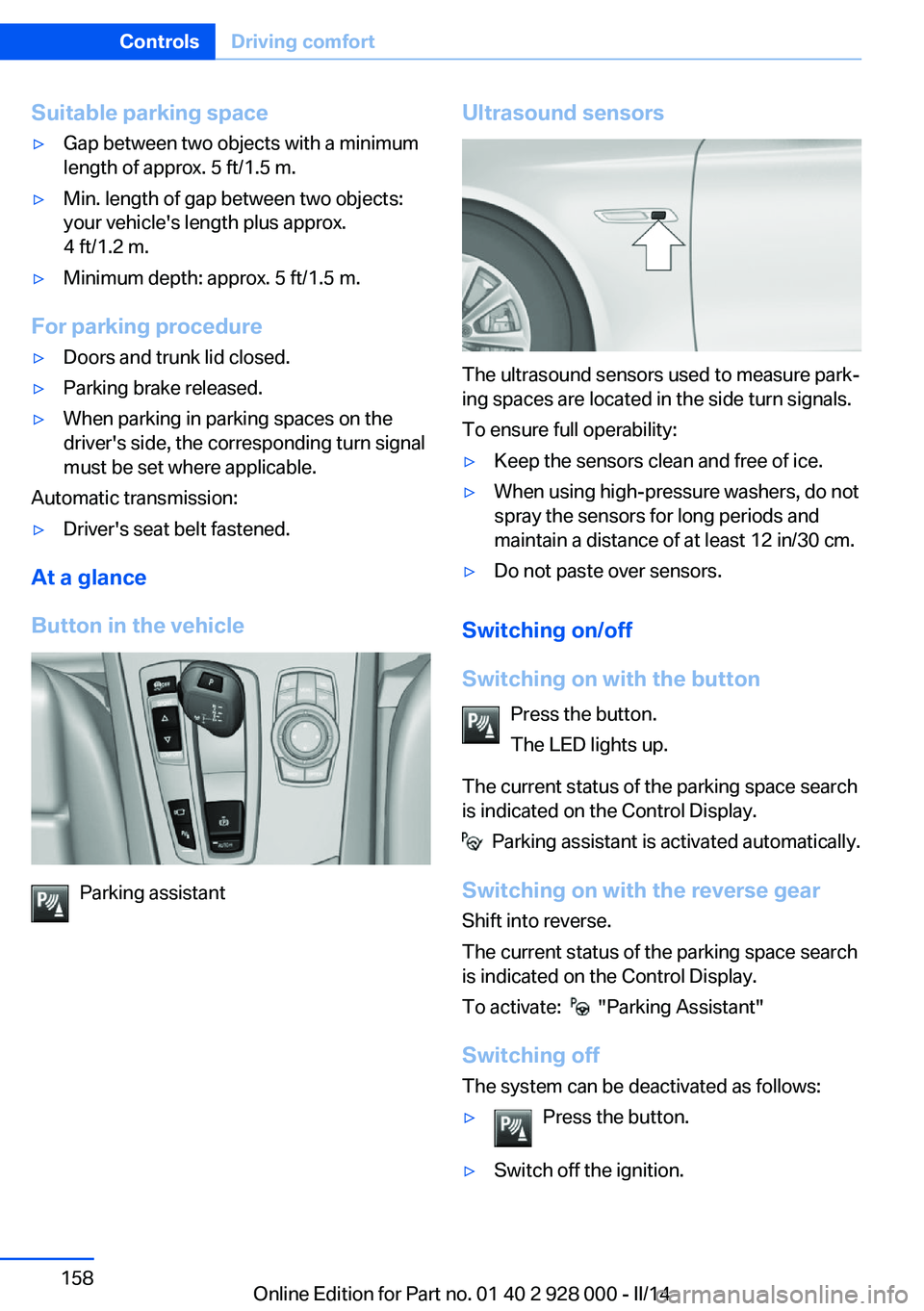
Suitable parking space‚Ė∑Gap between two objects with a minimum
length of approx. 5 ft/1.5 m.‚Ė∑Min. length of gap between two objects:
your vehicle's length plus approx.
4 ft/1.2 m.‚Ė∑Minimum depth: approx. 5 ft/1.5 m.
For parking procedure
‚Ė∑Doors and trunk lid closed.‚Ė∑Parking brake released.‚Ė∑When parking in parking spaces on the
driver's side, the corresponding turn signal
must be set where applicable.
Automatic transmission:
‚Ė∑Driver's seat belt fastened.
At a glance
Button in the vehicle
Parking assistant
Ultrasound sensors
The ultrasound sensors used to measure park‚Äź
ing spaces are located in the side turn signals.
To ensure full operability:
‚Ė∑Keep the sensors clean and free of ice.‚Ė∑When using high-pressure washers, do not
spray the sensors for long periods and
maintain a distance of at least 12 in/30 cm.‚Ė∑Do not paste over sensors.
Switching on/off
Switching on with the button Press the button.
The LED lights up.
The current status of the parking space search
is indicated on the Control Display.
Parking assistant is activated automatically.
Switching on with the reverse gear
Shift into reverse.
The current status of the parking space search
is indicated on the Control Display.
To activate:
"Parking Assistant"
Switching off The system can be deactivated as follows:
‚Ė∑Press the button.‚Ė∑Switch off the ignition.Seite 158ControlsDriving comfort158
Online Edition for Part no. 01 40 2 928 000 - II/14
Page 161 of 267
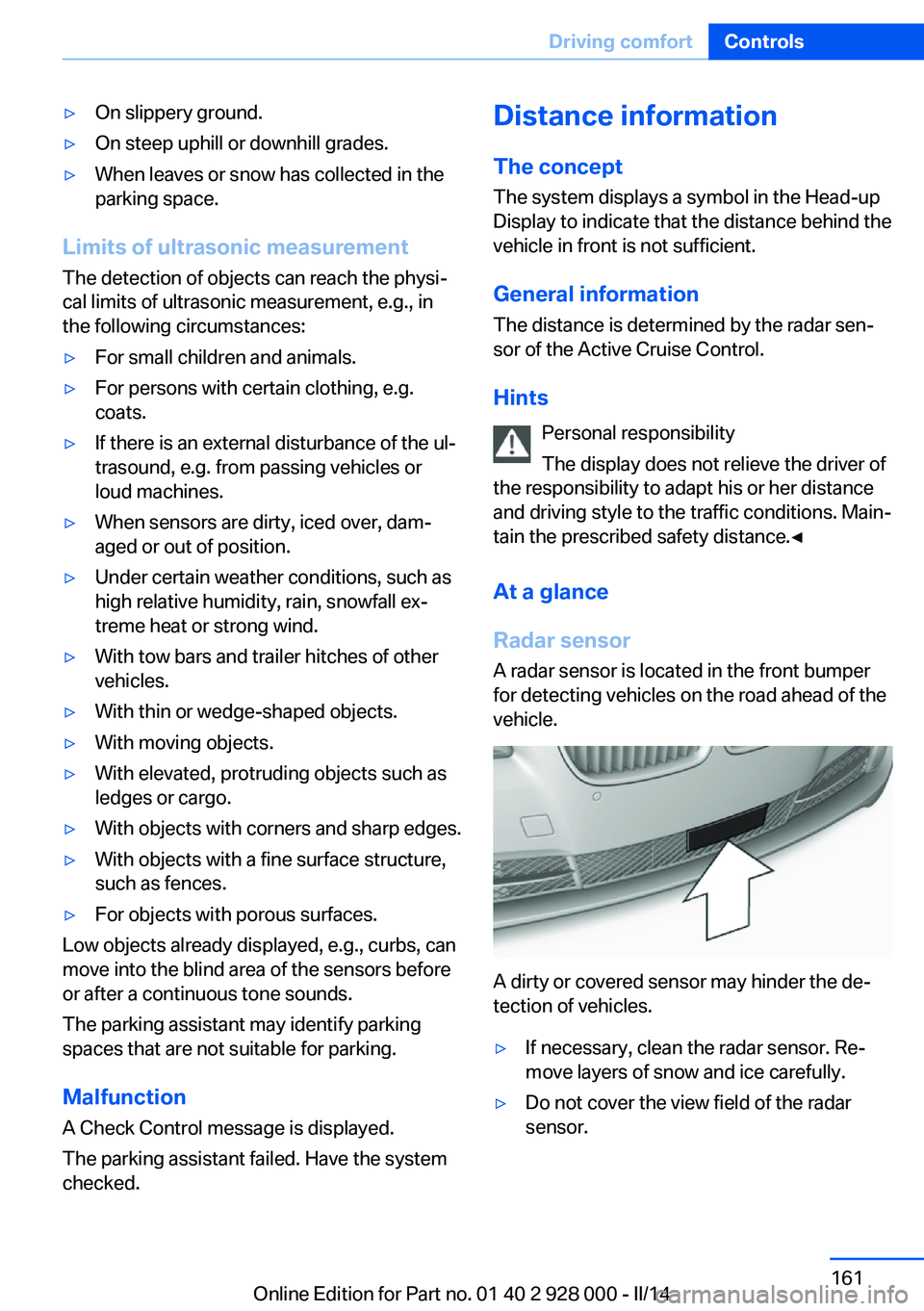
‚Ė∑On slippery ground.‚Ė∑On steep uphill or downhill grades.‚Ė∑When leaves or snow has collected in the
parking space.
Limits of ultrasonic measurement
The detection of objects can reach the physi‚Äź
cal limits of ultrasonic measurement, e.g., in
the following circumstances:
‚Ė∑For small children and animals.‚Ė∑For persons with certain clothing, e.g.
coats.‚Ė∑If there is an external disturbance of the ul‚Äź
trasound, e.g. from passing vehicles or
loud machines.‚Ė∑When sensors are dirty, iced over, dam‚Äź
aged or out of position.‚Ė∑Under certain weather conditions, such as
high relative humidity, rain, snowfall ex‚Äź
treme heat or strong wind.‚Ė∑With tow bars and trailer hitches of other
vehicles.‚Ė∑With thin or wedge-shaped objects.‚Ė∑With moving objects.‚Ė∑With elevated, protruding objects such as
ledges or cargo.‚Ė∑With objects with corners and sharp edges.‚Ė∑With objects with a fine surface structure,
such as fences.‚Ė∑For objects with porous surfaces.
Low objects already displayed, e.g., curbs, can
move into the blind area of the sensors before
or after a continuous tone sounds.
The parking assistant may identify parking
spaces that are not suitable for parking.
Malfunction
A Check Control message is displayed.
The parking assistant failed. Have the system
checked.
Distance information
The conceptThe system displays a symbol in the Head-up
Display to indicate that the distance behind the
vehicle in front is not sufficient.
General information
The distance is determined by the radar sen‚Äź
sor of the Active Cruise Control.
Hints Personal responsibility
The display does not relieve the driver of
the responsibility to adapt his or her distance
and driving style to the traffic conditions. Main‚Äź
tain the prescribed safety distance.‚óÄ
At a glance
Radar sensor A radar sensor is located in the front bumper
for detecting vehicles on the road ahead of the
vehicle.
A dirty or covered sensor may hinder the de‚Äź
tection of vehicles.
‚Ė∑If necessary, clean the radar sensor. Re‚Äź
move layers of snow and ice carefully.‚Ė∑Do not cover the view field of the radar
sensor.Seite 161Driving comfortControls161
Online Edition for Part no. 01 40 2 928 000 - II/14
Page 162 of 267
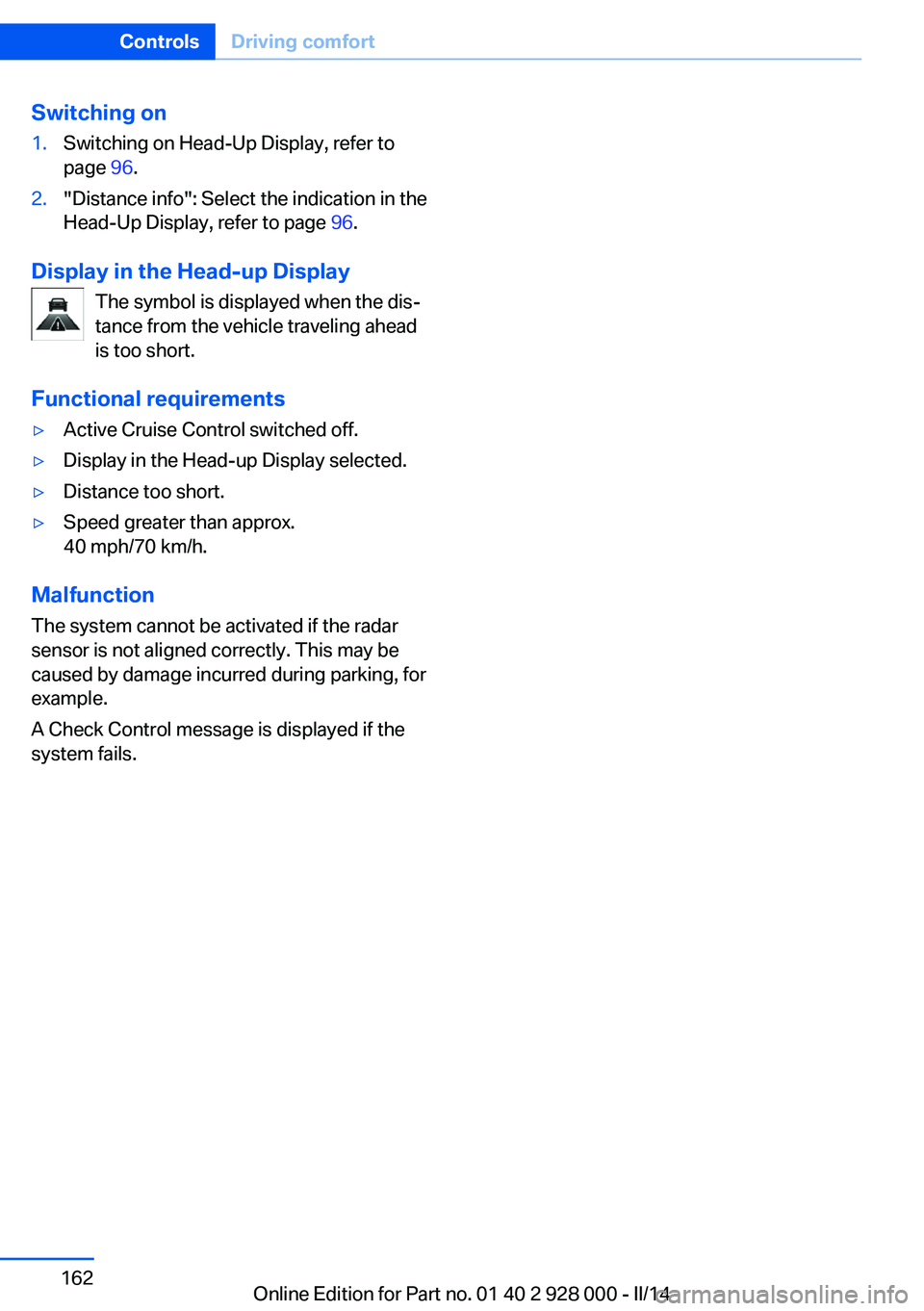
Switching on1.Switching on Head-Up Display, refer to
page 96.2."Distance info": Select the indication in the
Head-Up Display, refer to page 96.
Display in the Head-up Display
The symbol is displayed when the dis‚Äź
tance from the vehicle traveling ahead
is too short.
Functional requirements
‚Ė∑Active Cruise Control switched off.‚Ė∑Display in the Head-up Display selected.‚Ė∑Distance too short.‚Ė∑Speed greater than approx.
40 mph/70 km/h.
Malfunction
The system cannot be activated if the radar
sensor is not aligned correctly. This may be
caused by damage incurred during parking, for
example.
A Check Control message is displayed if the
system fails.
Seite 162ControlsDriving comfort162
Online Edition for Part no. 01 40 2 928 000 - II/14
Page 164 of 267
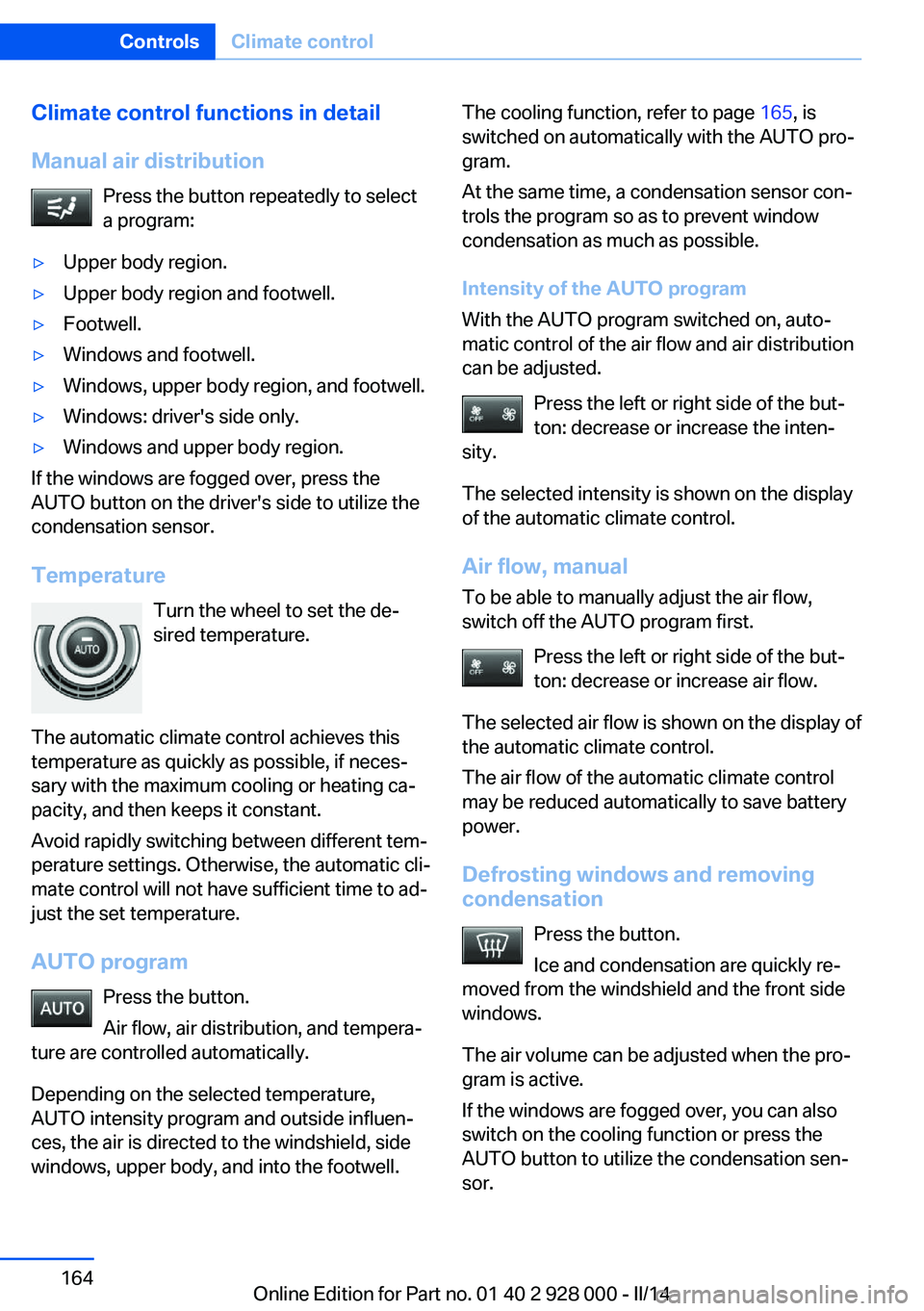
Climate control functions in detail
Manual air distribution Press the button repeatedly to select
a program:‚Ė∑Upper body region.‚Ė∑Upper body region and footwell.‚Ė∑Footwell.‚Ė∑Windows and footwell.‚Ė∑Windows, upper body region, and footwell.‚Ė∑Windows: driver's side only.‚Ė∑Windows and upper body region.
If the windows are fogged over, press the
AUTO button on the driver's side to utilize the
condensation sensor.
Temperature Turn the wheel to set the de‚Äźsired temperature.
The automatic climate control achieves this
temperature as quickly as possible, if neces‚Äź
sary with the maximum cooling or heating ca‚Äź
pacity, and then keeps it constant.
Avoid rapidly switching between different tem‚Äź
perature settings. Otherwise, the automatic cli‚Äź
mate control will not have sufficient time to ad‚Äź
just the set temperature.
AUTO program Press the button.
Air flow, air distribution, and tempera‚Äź
ture are controlled automatically.
Depending on the selected temperature,
AUTO intensity program and outside influen‚Äź ces, the air is directed to the windshield, side
windows, upper body, and into the footwell.
The cooling function, refer to page 165, is
switched on automatically with the AUTO pro‚Äź
gram.
At the same time, a condensation sensor con‚Äź
trols the program so as to prevent window
condensation as much as possible.
Intensity of the AUTO program
With the AUTO program switched on, auto‚Äź
matic control of the air flow and air distribution
can be adjusted.
Press the left or right side of the but‚Äź
ton: decrease or increase the inten‚Äź
sity.
The selected intensity is shown on the display
of the automatic climate control.
Air flow, manual To be able to manually adjust the air flow,
switch off the AUTO program first.
Press the left or right side of the but‚Äź
ton: decrease or increase air flow.
The selected air flow is shown on the display of
the automatic climate control.
The air flow of the automatic climate control
may be reduced automatically to save battery
power.
Defrosting windows and removing condensation
Press the button.
Ice and condensation are quickly re‚Äź
moved from the windshield and the front side
windows.
The air volume can be adjusted when the pro‚Äź
gram is active.
If the windows are fogged over, you can also
switch on the cooling function or press the
AUTO button to utilize the condensation sen‚Äź
sor.Seite 164ControlsClimate control164
Online Edition for Part no. 01 40 2 928 000 - II/14
Page 165 of 267
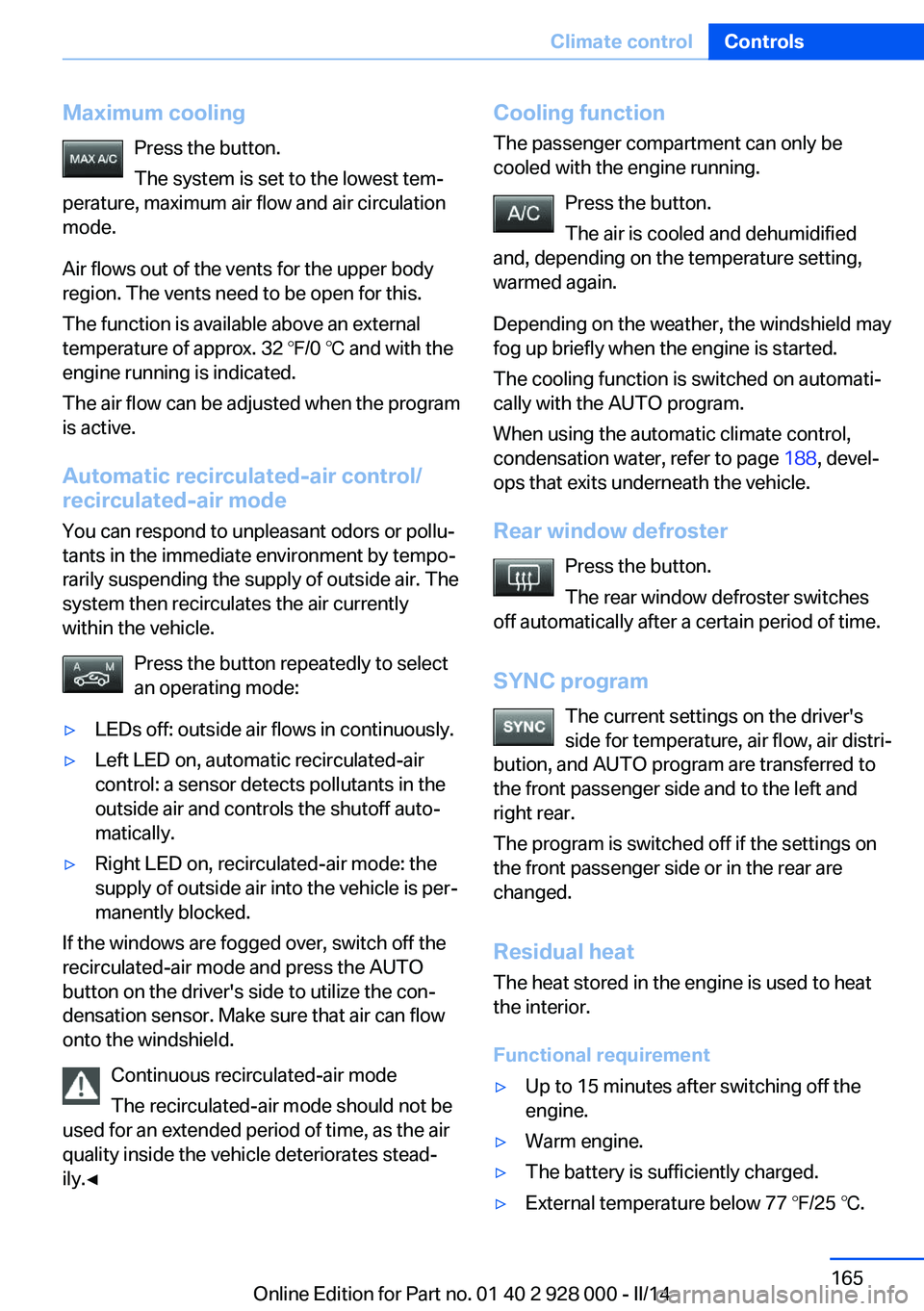
Maximum coolingPress the button.
The system is set to the lowest tem‚Äź
perature, maximum air flow and air circulation
mode.
Air flows out of the vents for the upper body
region. The vents need to be open for this.
The function is available above an external
temperature of approx. 32 ‚ĄČ/0 ‚ĄÉ and with the
engine running is indicated.
The air flow can be adjusted when the program
is active.
Automatic recirculated-air control/ recirculated-air mode
You can respond to unpleasant odors or pollu‚Äź
tants in the immediate environment by tempo‚Äź
rarily suspending the supply of outside air. The
system then recirculates the air currently
within the vehicle.
Press the button repeatedly to select
an operating mode:‚Ė∑LEDs off: outside air flows in continuously.‚Ė∑Left LED on, automatic recirculated-air
control: a sensor detects pollutants in the
outside air and controls the shutoff auto‚Äź
matically.‚Ė∑Right LED on, recirculated-air mode: the
supply of outside air into the vehicle is per‚Äź
manently blocked.
If the windows are fogged over, switch off the
recirculated-air mode and press the AUTO
button on the driver's side to utilize the con‚Äź
densation sensor. Make sure that air can flow
onto the windshield.
Continuous recirculated-air mode
The recirculated-air mode should not be
used for an extended period of time, as the air
quality inside the vehicle deteriorates stead‚Äź
ily.‚óÄ
Cooling function
The passenger compartment can only be
cooled with the engine running.
Press the button.
The air is cooled and dehumidified
and, depending on the temperature setting,
warmed again.
Depending on the weather, the windshield may
fog up briefly when the engine is started.
The cooling function is switched on automati‚Äź
cally with the AUTO program.
When using the automatic climate control,
condensation water, refer to page 188, devel‚Äź
ops that exits underneath the vehicle.
Rear window defroster Press the button.
The rear window defroster switches
off automatically after a certain period of time.
SYNC program The current settings on the driver's
side for temperature, air flow, air distri‚Äź
bution, and AUTO program are transferred to
the front passenger side and to the left and
right rear.
The program is switched off if the settings on
the front passenger side or in the rear are
changed.
Residual heat The heat stored in the engine is used to heat
the interior.
Functional requirement‚Ė∑Up to 15 minutes after switching off the
engine.‚Ė∑Warm engine.‚Ė∑The battery is sufficiently charged.‚Ė∑External temperature below 77 ‚ĄČ/25 ‚ĄÉ.Seite 165Climate controlControls165
Online Edition for Part no. 01 40 2 928 000 - II/14
Page 231 of 267
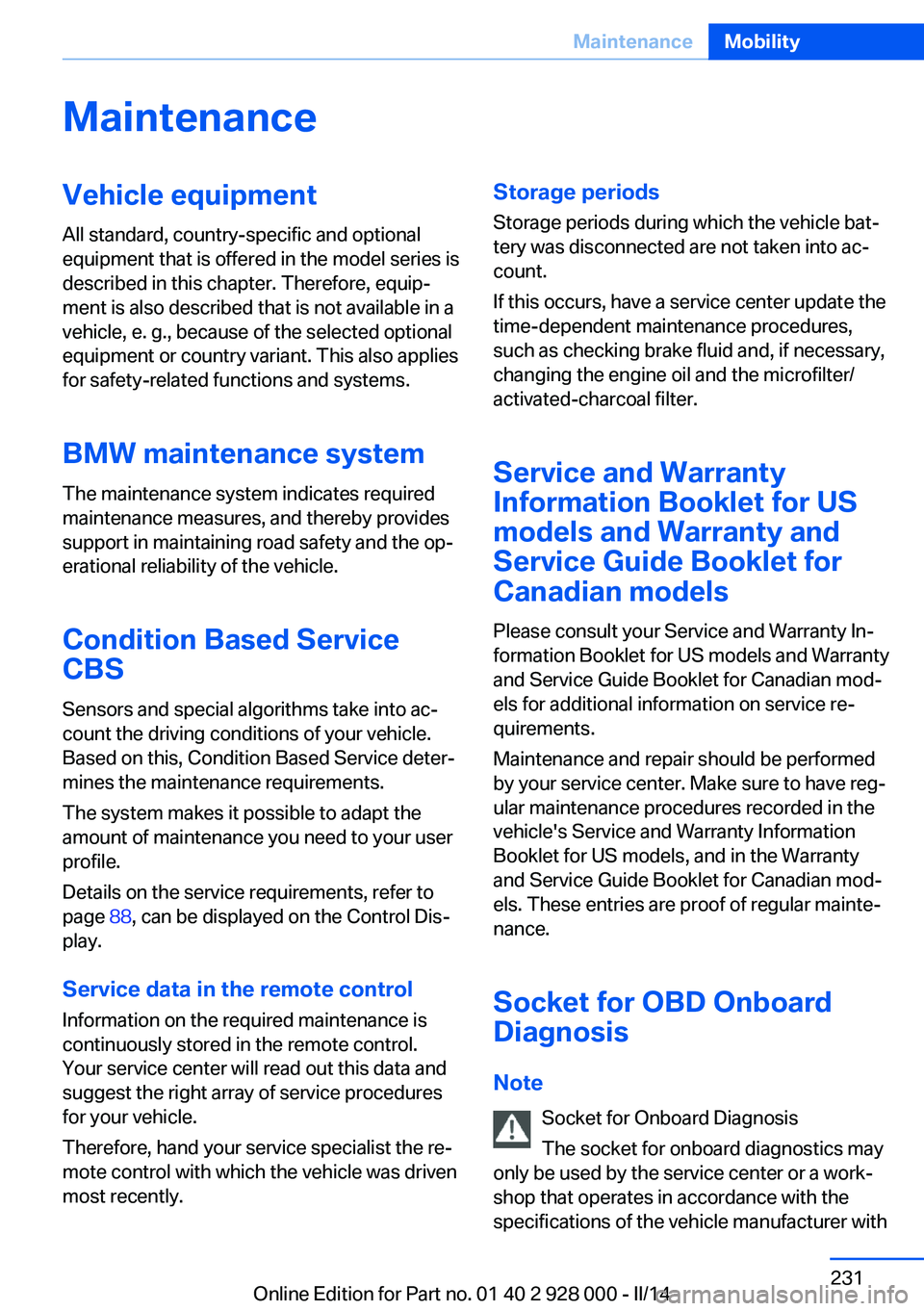
MaintenanceVehicle equipment
All standard, country-specific and optional
equipment that is offered in the model series is
described in this chapter. Therefore, equip‚Äź
ment is also described that is not available in a
vehicle, e. g., because of the selected optional
equipment or country variant. This also applies
for safety-related functions and systems.
BMW maintenance system The maintenance system indicates required
maintenance measures, and thereby provides
support in maintaining road safety and the op‚Äź erational reliability of the vehicle.
Condition Based Service
CBS
Sensors and special algorithms take into ac‚Äź
count the driving conditions of your vehicle.
Based on this, Condition Based Service deter‚Äź
mines the maintenance requirements.
The system makes it possible to adapt the
amount of maintenance you need to your user
profile.
Details on the service requirements, refer to
page 88, can be displayed on the Control Dis‚Äź
play.
Service data in the remote control Information on the required maintenance is
continuously stored in the remote control.
Your service center will read out this data and
suggest the right array of service procedures
for your vehicle.
Therefore, hand your service specialist the re‚Äź
mote control with which the vehicle was driven
most recently.Storage periods
Storage periods during which the vehicle bat‚Äź
tery was disconnected are not taken into ac‚Äź
count.
If this occurs, have a service center update the
time-dependent maintenance procedures,
such as checking brake fluid and, if necessary,
changing the engine oil and the microfilter/
activated-charcoal filter.
Service and Warranty Information Booklet for US
models and Warranty and
Service Guide Booklet for
Canadian models
Please consult your Service and Warranty In‚Äź
formation Booklet for US models and Warranty
and Service Guide Booklet for Canadian mod‚Äź els for additional information on service re‚Äź
quirements.
Maintenance and repair should be performed
by your service center. Make sure to have reg‚Äź
ular maintenance procedures recorded in the
vehicle's Service and Warranty Information
Booklet for US models, and in the Warranty
and Service Guide Booklet for Canadian mod‚Äź
els. These entries are proof of regular mainte‚Äź
nance.
Socket for OBD Onboard
Diagnosis
Note Socket for Onboard Diagnosis
The socket for onboard diagnostics may
only be used by the service center or a work‚Äź
shop that operates in accordance with the
specifications of the vehicle manufacturer withSeite 231MaintenanceMobility231
Online Edition for Part no. 01 40 2 928 000 - II/14